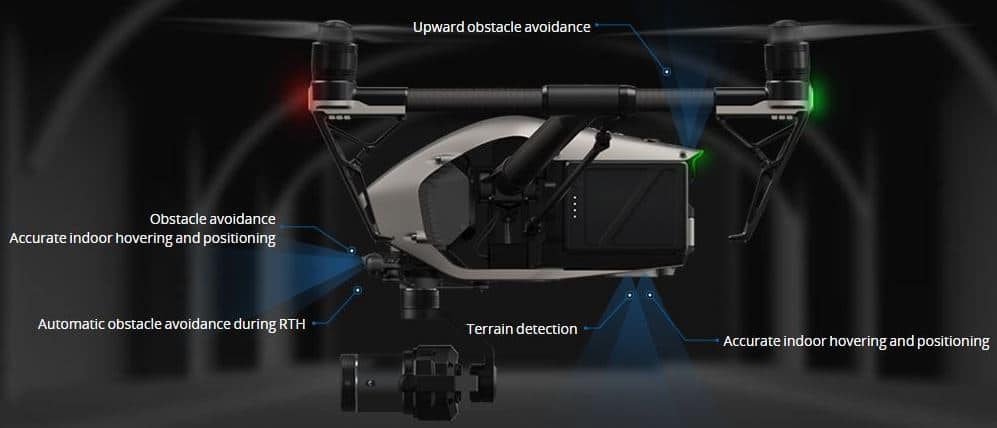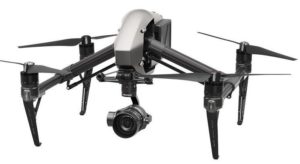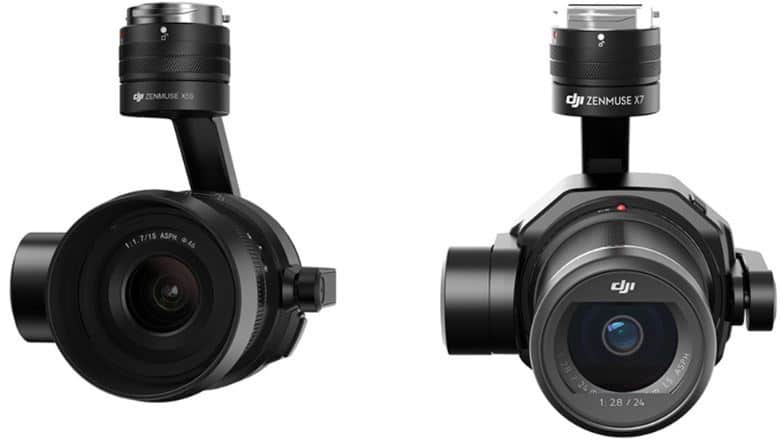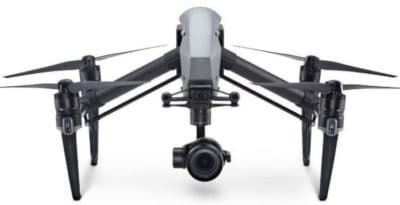This DJI Inspire 2 review looks at the specs, features and your frequently asked questions on this top aerial cinematography quadcopter.
The Inspire 2 advanced flight, stability, gimbal, camera, obstacle detection, along with excellent safety features are much better than larger and more pricey drones on the market.
This review also covers DJI Inspire 2 specifications such as range, distance, dimensions, max height, altitude, frequency, video transmission, gimbals, cameras, safety technology and much more.
We have some terrific DJI Inspire 2 YouTube videos sprinkled throughout.
Manuals are very important and we have links to the DJI Inspire 2 user manuals.
The DJI Inspire 2 price various depending on gimbal and camera options and we show you the best Inspire 2 combo deals and camera options.
DJI Inspire 2 Review And FAQs
The DJI Inspire 2 launch was in November, 2016 and blew everyone away. This professional quadcopter was packed with new innovation making it the top drone for professional aerial cinematography, which still stands today.
Hollywood movie makers and top advertisers love the Inspire 2 because of the stunning quality of the images and aerial film. The Inspire 2 flight speed and agility is very impressive making it ideal for action filming.
The Inspire 2 can be used to film both ground and aerial film. In fact a short film called The Circle was filmed 100% with the Inspire 2 and Zenmuse X5S camera.
The Inspire 2 can also be used for high precision 3D mapping and photogrammetry.
Now, let’s delve in the the Inspire 2 specs, features and FAQs, which make this quadcopter the best choice for aerial imagery and filming.
Inspire 2 Features and Specifications Review
DJI Inspire 2 Weight
The DJI Inspire 2 weight is 7.58 lbs (3.440 kg), including propellers and two batteries, without gimbal and camera.
DJI Inspire 2 Distance Range
The Inspire 2 has a maximum transmission distance or range of 4.3 miles (7 km).
This Inspire 2 quadcopter uses the latest DJI Lightbridge technology, giving it a maximum transmission range of up to 4.3 miles (7 km).
At this range the Inspire 2 quadcopter is capable of delivering both 1080p/720p video as well as the FPV view to pilot and camera operator. In other words, you can receive the live video to both master pilot and slave remote controllers.
The video latency from the Inspire 2 to the live view on smartphone or tablet is below 220 milliseconds.
DJI Inspire 2 Flight Time
Inspire 2 Operating Frequencies
DJI Inspire 2 Speed
The DJI Inspire 2 speed is 58 mph (94 km/h), which is pretty impressive. This equates to 4.4 lbs (2 kg) of thrust per motor.
- Max Ascent Speed – 19.68 feet per second (6 meters per second in Sport mode.
- Max Descent Speed – Vertical, 13.1 feet per second (4 meters per second).
DJI Inspire 2 Dimensions
The Inspire 2 quadcopter dimensions are as follows;
- Length – 16.81 inches (42.7 cm).
- Height – 12.48 inches (31.7 cm).
- Width – 16.73 inches (42.5 cm), without propellers.
DJI Inspire 2 Obstacle Detection
The Inspire 2 can detect obstacles up to 100 feet (30 meters) ahead using its vision system, while flying at or below 34 mph (54 km/h) and at a controllable attitude angle of 25°.
The Inspire 2 also has upward facing infrared sensors scanning for obstacles 16 feet (5 meters) above, adding protection when flying in enclosed spaces or under bridges etc.
These obstacle sensing systems are active during normal flight, Return-To-Home and all Intelligent Flight Modes. These sensors are core components of the DJI Flight autonomy system, which brings the below intelligent features to the Inspire 2.

DJI Inspire 2 Spotlight Pro Intelligent Modes
Spotlight Pro is a tracking mode, which allows single pilots to capture complex, dramatic images. It uses advanced visual tracking algorithms to lock onto a subject during flight, no matter which direction the Inspire 2 flies, creating shots, which require a dedicated camera operator without this intelligent flight mode.
If the gimbal comes close to reaching its rotation limits, the Inspire 2 itself will rotate in the same direction without affecting flight control.
The Inspire 2 Spotlight Pro has two shooting modes, which are Quick Mode and Composition Mode.
In Quick Mode, select an object to begin tracking. In Composition Mode, select the subject and the tracking position. When the subject enters the preset tracking position, press the shortcut to begin tracking. The gimbal can be moved during shooting for composition adjustments.
Spotlight Pro is available in Intelligent Flight Modes TapFly, Waypoint, and Point of Interest.
DJI Inspire 2 TapFly Intelligent Flight Mode
The 2 axis onboard FPV camera separates the flight view from the main camera view, giving the Inspire 2 a dedicated TapFly camera. Tap a point onscreen in the FPV view to set a flight route and the Inspire 2 will automatically fly along the route, leaving the pilot to focus on gimbal movement and filming.
DJI Inspire 2 ActiveTrack Intelligent Flight Mode
The Inspire 2 ActiveTrack Mode allows the Inspire 2 to recognize a range of objects, from people to bikes to cars and boats. Tracking profiles can be adjusted based on the subject being tracked meaning greater tracking precision.
DJI Inspire 2 Smart Return To Home Safety Mode
At takeoff, the Inspire 2 records it’s home point coordinates. Then if there is a loss of GPS signal, loss of transmission to the remote control, low battery or errors, the Inspire 2 will enter Return-To-Home mode.
Forward and downward vision systems allow the Inspire 2 to create a real-time map of its flight route as it flies.
If the video transmission system signal is lost and Smart Return Home is enabled, it is able to fly home along its original route, and change to a straight line when it regains a signal.
As it returns, it will use the primary camera to identify obstacles as far as 656 feet (200 meters) in front, allowing it to plan a safe route home.
It is also able to reconnect more quickly after losing connection.
DJI Inspire 2 Price, Bundles And Combo Deals

The Inspire 2 price varies from approximately USD 3,499 for the standard Inspire 2 without gimbal and camera. There are Inspire 2 drone bundles without gimbal or camera available. These start at the USD 2,999 price range.
There are no Inspire 2 bundles listed on Amazon. So the best way to purchase is from DJI directly on their Inspire 2 page where you can build your own Inspire 2 bundle choosing gimbal and camera etc.
DJI Inspire 2 Dual Systems For Superb Reliability
The Inspire 2 had added new redundancy for extra reliability. DJI have further enhanced the reliability of the Inspire 2 by adding dual IMU, dual barometer and dual batteries. The intelligent flight control system monitors the redundancy system, giving it accurate flight data.
Dual batteries mean that if a problem occurs on one battery the other is able to continue flying long enough for a safe landing.
At the same time, the Inspire 2 propulsion system is driven a PWM signal with serial port signal redundancy so that if PWM signals are lost, transmission will continue through the serial port.
This propulsion system has been tested for thousands of hours to ensure reliability, when combined with key sensors and a dual-battery design, overall flight reliability is significantly enhanced.
DJI Inspire 2 Satellite Connectivity
DJI use both GPS and GLONASS for satellite navigation giving stronger signal.
DJI Inspire 2 SD Cards
The Inspire 2 quadcopter comes with a 16 GB Micro SD card. It supports SD cards up to 128 GB in size. The current recommended supported SD cards are as follows;
- SanDisk Extreme 32 – 64 GB UHS-3 V30 Micro SDXC
- Panasonic 32 – 64 GB UHS-3 Micro SDHC
- Samsung PRO 32 GB UHS-1 Micro SDHC
- Samsung PRO 64 – 128 GB UHS-3 Micro SDXC
Inspire 2 Camera Options Review
The Inspire 2 has a number of compatible Zenmuse camera options. For professional aerial imagery and film making, the Inspire 2 cameras are the Zenmuse X5S and Zenmuse X7.
Now, lets take a quick review of both the X5S and X7 for the Inspire 2.
Both cameras use the Inspire 2 image processing system called CineCore 2.1.
CineCore 2.1 Image Processing System
The Inspire 2 creative workflow is now optimized and is capable of recording video in CinemaDNG and Apple ProRes along with other common formats for post production in film making.
The Inspire 2 image processing system CineCore 2.1, records video at up to 6k in CinemaDNG/RAW and 5.2k in Apple ProRes when used with the Zenmuse X7 camera. With the Zenmuse X7, you can film as follows;
- 6k at 4.44 Gbps in CinemaDNG.
- 5.2k at 2.08 Gbps Apple ProRes.
- H.265/H.264 at 100 Mbps.
CineCore 2.1 supports burst shots, capturing 10 JPEG + DNG bursts and continuous DNG bursts at 20 frames per second (24 megapixel per shot) when the Zenmuse X7 is mounted.
CineCore 2.1 is currently compatible with the X7 and X5S cameras.
Zenmuse X5S Quick Review
The Zenmuse X5S camera is equipped with a Micro 4/3 sensor and has a dynamic range of 12.8 stops, with a much improved signal to noise ratio and color sensitivity over its predecessor, the X5R.
This X5S camera supports up to eight standard M4/3 lenses (including zoom lenses) with focal lengths ranging from 9 mm – 45 mm(equivalent to 18 mm – 90 mm on a 35 mm camera), allowing for more creative flexibility.
The new CineCore 2.1 image processing system on the Inspire 2 makes the Zenmuse X5S capable of capturing the following;
- 5.2k @ 30 frames per second in CinemaDNG video and Apple ProRes video
- 4k @ 60 frames per second using H.264
- 4k @ 30 frames per second using H.265 (both at 100 Mbps)
- 20.8 megapixel stills
- 20 frames per second continuous burst
Zenmuse X5S Compatible Lenses
Since it uses a standard Micro 4/3 mount, the Zenmuse X5S now supports up to eight professional lenses with focal lengths ranging from 9 to 45 mm (equivalent to 18 mm to 90 mm on a 35 mm camera), providing more creative control over the final look of a shot.
Here is a quick video where producers of the short film called The Circle describe how they used the Inspire 2 and X5S camera throughout.
Zenmuse X7 Quick Overview
The Zenmuse X7 is a compact Super 35 camera with an integrated gimbal made for high end film making. The DJI X7 camera delivers stunning resolution and image quality.
This Zenmuse X7 has a 24 megapixel CMOS sensor rated at 14 stops of dynamic range to preserve astonishing detail along with offering both 6k resolution in CinemaDNG and 5.2k Apple ProRes.
The X7 camera support for continuous RAW burst shooting at 20 frames per second and 24 megapixel stills. The X7 has the new DL-Mount, which is the world’s first integrated aerial lens mount.
This allows for quick switching between 4 available prime lenses. For seamless editing, a new DJI Cinema Color System preserves accurate colors for easier post processing.
- 6k CinemaDNG
- 5.2k Apple ProRes
- Super 35 sensor
- 14 Stops of Dynamic Range
- 24 MP stills
About The DJI DL Mount System For Zenmuse X7
Taking advantage of new technology, the X7 sensor features thinner interconnections, allowing light to reach the sensing area via a larger incident angle for increased photo sensitivity.
This enables a more compact lens mount to be used on this sensor, while maintaining excellent image quality.
The flange focal distance of the DL-Mount is less than 17 mm. This compact mount means that the X7 weighs only about 1.4 lbs (630 grams) with a lens attached.
Together, the X7 and Inspire 2 weigh around just 8.8 lbs (4 kg) and has the ability to capture the same challenging shots as more heavy duty drones weighing up to 88 lbs (40 kg) and for much less.
Zenmuse X7 Compatible Lenses
DJI offers four Zenmuse X7 prime lenses for the DL-Mount system, with focal lengths ranging from 16 to 50 mm and resolutions of up to 8k.
These four prime lenses for the Zenmuse X7 are made of lightweight carbon fiber and designed by world leading optics teams. The four lenses have been embedded with advanced technologies crafted specifically for the X7 high end image sensor.
This next video is the actual launch of the Zenmuse X7 on the Inspire 2. It shows the Zenmuse X7 on the Inspire 2 being used to film both indoors and outdoors with superb quality and vivid colors.
DJI Cinema Color System
To unlock the wide ranging possibilities of DJI professional imaging systems and open more room for post-processing aerial photography in film making, DJI designed a new DJI Cinema Color System.
This color system consists of a new D-Log curve and a D-Gamut RGB color space. The D-Log can encode 15 stops of dynamic range, two stops higher than the CineCore 2.0. Even in poor light conditions, the X7 can still preserve stunning detail in shadows and highlights, leaving more room for post production creativity.
D-Gamut covers the entire DCI-P3 color space commonly used in film making. Tailored for aerial cinematography and stills photography, D-Gamut provides larger green tone coverage, delivering beautiful green gradation for your shoots.
D-Gamut also offers optimized skin tone adjustment by moving these tones to the most suitable chromaticity, ensuring vivid colors are reflected from every inch of skin. By applying the dedicated 3D-LUT in color grading, skin tones will softly transition, even with wide exposure differences.
When designing D-Gamut, DJI considered manual color grading, preventing skin tones from turning yellow when editing without 3D-LUT or color management.
Zenmuse X5S versus X7 Cameras

The main difference between the Zenmuse X5S and X7 is related to the sensor size and also the price.
The Zenmuse X5S uses a Micro Four Thirds (MFT) sensor, while the X7 embarks an APS-C sensor.
In fact, the X7 uses the Super 35 mm area of the APS-C sensor (23.5×12.5 mm) in video mode and the full sensor size (23.5×15.7 mm) in stills mode.
On a physical standpoint, the X7 sensor is about 50 percent larger than the X5S sensor. More sensor surface means better dynamic range and better low light performance.
DJI states that the X7 reaches 14 stops of dynamic range against 12.8 stops for the X5S. High ISO images should also display less noise.
In terms of photography, the adoption of the APS-C standard means the pictures will be wider because of the 3:2 ratio instead of the squarish 4:3 images produced by a Micro Four-Thirds camera.
The X7 camera comes with 24 megapixels against 20.8 megapixels for the X5S.
This resolution on the 3:2 sensor is the minimum required to deliver a true 6K video mode. With its 20.8 megapixel MFT sensor, the X5 camera can film in 5.2k resolution because of the limited width resolution (5280 pixels wide).
The Zenmuse X7 can record in 6k resolution with an aspect ratio of 17:1 (6016 × 3200) or 16:9 (5760 × 3240) up to 30 frames per seconds.
The 6k mode is only available in the 12 bits CinemaDNG format. In this mode, the amount of data recorded each second is gigantic (4.4 Gbps).
A small 120 GB SSD will be full in a few minutes at this rate. But the X5S faces the same issue when using its maximum resolution of 5.2k.
Less weight means more flying time so a lighter camera is good to have. The newer X7 is slightly lighter at 0.99 lbs (449 grams) than the X5S 1.01 lbs (461 grams).
However the big difference come from the lenses.
DJI designed a native optical system for the X7 with a new DL lens mount. This has an very short flange focal distance in order to obtain a compact system with the lens attached as close as possible to the sensor, allowing for optimal weight distribution on the gimbal.
Essentially, every part around the optic is reduced to the minimum (no ring, switch or window) and the lens casing is made out of carbon fiber.
The four prime lenses introduced by DJI for the Zenmuse X7 only weight 180 grams. All of them come with a maximum aperture of f/2.8 and cover the common focal range from 24 mm, 36 mm, 53 mm, to 75 mm in 35 mm equivalent.
These are the main differences between the Zenmuse X5S and X7 cameras for the Inspire 2.
To read further on the differences read this excellent Zenmuse X5S vs X7 camera article.
Zenmuse X5S versus X7 Camera Comparison
You can view a very well presented Zenmuse X7 vs X5S comparision chart here. This includes the Zenmuse X4S, which is no longer available.
Zenmuse X5S and X7 Manuals
Here are the links to the Zenmuse X5S and X7 user manuals, where you study the exact details and specifications of each.
DJI Inspire 2 Battery Life
A dual battery system prolongs the flight time to a maximum of 27 minutes, while self-heating technology allows it to fly even in low temperatures.
The Inspire 2 battery life should give a couple of hundred flights. However, there are certain conditions, which can cause the battery life to shorten while following DJI battery best practices will prolong the Inspire 2 battery life.
The Inspire 2 quadcopter battery has a capacity of 4280 mAh, a voltage of 22.8 and a smart discharge function giving the Inspire 2 battery a longer life.
The battery automatically discharges to below 70% of total power when it is idle for more than 10 days to prevent swelling. It takes around 3 days to discharge the battery to 65%.
The operating and charging temperature are from 5° to 40° Celsius (41° to 104° Fahrenheit).
You can read all the information on the DJI Inspire 2 battery life on pages 29 to 34 of the DJI Inspire 2 manual. Link to the Inspire 2 manuals is below.
You can also read this excellent article which covers general drone battery life and care.
How Long Does It Take To Charge Inspire 2 Batteries?
You will get a 180 watt battery charger and a battery charging hub in the box with your Inspire 2. When connecting the standard battery charger to the battery charging hub, it takes about 90 minutes to charge 2 batteries and 180 minutes to charge 4 batteries.
Inspire 2 Remote Controller Battery
The remote controller is equipped with a 6,000 mAh LiPo 2S battery. Fully charging the Inspire 2 remote controller takes approximately 3 hours. It can be used for approximately 4 hours after being fully charged.
Can The Inspire 2 Fly If Batteries Are At Different Charge Level?
The Inspire 2 can take off if the power discrepancy of the two batteries is within 13%. If it is unable to take off, the DJI GO 4 app will inform you that “the power discrepancy in the two batteries is too large”.
Reason To Pair Both Inspire 2 Batteries
By charging and discharging a pair of batteries together you will maximize flight time and battery life.
DJI Inspire 2 Motor Specification
The Inspire 2 uses 3512 motors and 1550T propellers. DJI manufacture some of the best drone motors with power, stability and elegant design.
DJI Inspire 2 Manuals
Here is the link to the DJI Inspire 2 user manual. The manual is pretty thorough and contains Inspire 2 specifications, quadcopter parts, vision system, intelligent flight batteries, troubleshooting and much more.
You can also find Inspire 2 maintenance manuals, Intelligent Flight Battery and other DJI Inspire 2 manuals here.
DJI Inspire 2 Master And Slave Remote Controllers
2 remote controllers can be used with the DJI Inspire 2. This allows for the pilot to concentrate on flying and a 2nd operator to concentrate on capturing the camera action. The maximum effective distance between the Master and Slave controllers is 328 feet (100 meters) and both controllers will receive the same HD live view.
What Comes With The Inspire 2 In The Box?
When you purchase the very basic model without a gimbal or camera, you will receive the following along with the Inspire 2 quadcopter in the box;
- Remote Controller x 1
- Propellers Pairs x 4
- Intelligent Flight Battery x 2
- Battery Charger x 1
- 4 Battery Charging Hub x 1
- Power Cable x 1
- USB Cable (Double A Ports) x 1
- 16 GB Micro SD Card x 1
- Carrying Case x 1
- Gimbal Damper x 3
- Propeller Mounting Plates x 1
- Vision System Calibration Plate x 1
- Battery Insulation Sticker x 4
- DJI Inspire 2 Manuals x 4
DJI Inspire 2 Video Review
Here is perhaps the best video review of the Inspire 2.
DJI Inspire 2 Unboxing YouTube Video
Here is a terrific Inspire 2 unboxing YouTube video. It sure is a magnificent quadcopter.
DJI Inspire 2 Flight Test
Here is a terrific video of an Inspire 2 flight test in pretty window conditions.

